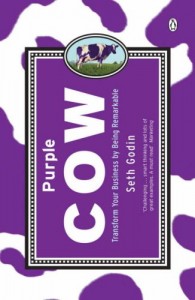 Seth Godin. If this name doesn’t sound familiar, he is the type of person that inspires thought. He makes you think and challenges to think deeper. His daily blog post (which arrives to me via email) is short, sweet, and to the point. And despite taking three minutes to read, I’ll think about his words throughout the day.
Seth Godin. If this name doesn’t sound familiar, he is the type of person that inspires thought. He makes you think and challenges to think deeper. His daily blog post (which arrives to me via email) is short, sweet, and to the point. And despite taking three minutes to read, I’ll think about his words throughout the day.
I unexpectedly found one one of his books in Rob’s office, so I asked if I could borrow it. Purple Cow is the thing that stands out in the every day scheme of life. Ordinary thoughts will never make a great memory. Doing your regular tasks at work will never get you that promotion you deserve. And the normal effort will never make that extraordinary ending.
So what does that mean? Godin was driving through farmland. Cow after cow after… cow. Then he stopped and pointed. “Check out that cow. It looks purple!” The cow stood out. His kids took interest. They stared. They took the purple cow down as a memory. They stared in curiosity. But soon, the newness faded. They grew bored, and they carried on. But the purple cow stood out.
The Purple Cow was then put on the product stage. Godin believes that the majority of people follow the “early adopting sneezers”. These are the people that take risk in buying something new and different. And then they recommend it to their friends. Take the iPhone. Initially people didn’t know what the heck it was. Then some of the Mac enthusiasts decided to try, and after their positive review, they told someone (sneezed), and now everyone owns it. And so, the strategy strays from targeting the general public. Rather, target and change your product, so “sneezers” will start telling others. Overall, the early adopters make the decision, so appeal to them.
How to do it. Interesting things aren’t normal. Friends don’t tell friends that they had a regular banana. Friends tell friends that they had the most extraordinary banana bread from “X” bakery. And their friends listened and remembered. They were the purple cow.
If you’re going to sell plants, do something different. Offer extraordinary customer service; when someone pays for seeds, show a picture of the “dad”; Or become the experts on music/human touch to extend a plant’s life. Do something … anything to separate you from what others are doing. And as soon as the others are doing it? Do something else.
Back to the iPhone. The iPhone revolutionized the mobile industry. What did they do recently? They … tried to revolutionize it again with “FaceTime”. They keep becoming “new” after their success. As the same with musics – Led Zeppelin, Madonna, Rolling Stones – they revolutionized themselves. And that’s how “new” brands last.
Godin is even a bit scared of the testing process. His point is that how can you be creative if you don’t get out of the general public’s comfort level. If you stray from the normal, people get uncomfortable and it fails. But it’s truly the remarkable ideas that fail in testing and excel when it reaches the market. He even used this example today. How well do you think shareholders thought of the idea to get Jack in the Box back on the map was with a guy with an oversized head. Point taken. It worked well.
Godin did seem to be a little too optimistic. Being different takes courage. And it’s the girth to try it – and either fail miserably or do well. But sometimes you need the right environment and the differentiator to make it happen. Everyone wishes they could do that. Everyone wishes they could come up with the idea that revolutionizes the industry. But it doesn’t happen. And he almost made it seem that others weren’t hungry to do this.
Either way, it was a good read. It made me think that if you aren’t personal branding than you’re normal. So how are you making yourself stray form the norm?
Here are some recent thoughts that I found intriguing from his blog:
